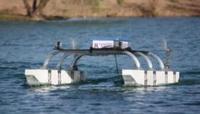-
Rapid, low-cost, point-of-care flu detection demonstrated

The novel H1N1 flu pandemic in 2009 underscored weaknesses in methods widely used to diagnose the flu, from frequent false negatives to long wait times for results; scientists demonstrate a prototype rapid, low-cost, accurate, point-of-care device that promises a better standard of care
-
-
Some flame retardants make fires more lethal
Almost 10,000 deaths from fires occur in industrialized countries worldwide each year, including about 3,500 in the United States; scientists find that widely used flame retardants added to carpets, furniture upholstery, plastics, crib mattresses, car, and airline seats and other products to suppress the visible flames in fires are actually increasing the danger of invisible toxic gases that are the No. 1 cause of death in fires
-
-
A swarm of small satellites to deflect menacing asteroids
New research suggests that the best way to divert an asteroid hurtling toward Earth is using a swarm of relatively small satellites flying in formation and cooperatively firing solar-powered lasers onto an asteroid; this would be a more effective way than the current methods being contemplated, which are focused on large unwieldy spacecraft
-
-
Developing crop for livestock in dry climates
Scientists at the University of Liverpool are working with international partners to develop new forage crop for the hot and dry climate of regions such as Pakistan and Saudi Arabia
-
-
Machine can tell when a human being is lying

In a study of forty cases, a computer correctly identifies liars more than 80 percent of the time, a better rate than humans with the naked eye typically achieve in lie-detection exercises
-
-
New plastics mimic human skin: they “bleed” when scratched, then heal
Plastics have become so common, replacing steel, aluminum, glass, paper, and other traditional materials because they combine desirable properties such as strength, light weight, and corrosion resistance; a new genre of plastics that mimic the human skin’s ability to heal scratches and cuts offers the promise of endowing military and first response gear – and consumer goods – with self-repairing surfaces
-
-
1930s technology to become 21st century tool against CO2 emissions
Human activity releases 30 billion tons of carbon dioxide into the air each year; a new approach to dealing with the problem has a back-to-the-future glint, leveraging technology that the petroleum industry has used since the 1930s to remove carbon dioxide and other impurities from natural gas
-
-
Earth's crust is slowly being destroyed
New research shows that the Earth’s crust is now undergoing high rates of destruction; the research shows the sharp decrease in the growth of the continental crust indicates a dramatic change in the way the Earth has generated and preserved this crust in the last 4.5 billion years
-
-
Planetary exploration vehicle for earthly search-and-rescue missions

A researcher develops a NASA-sponsored autonomous lake lander for the purpose of exploring lakes on distant planets; this mission is many years in the future; in the meantime, the vehicle is ready to deploy on missions related to defense and security, such as harbor surveillance and cleanup operations of littoral munitions dumps and mines; it is also ideal for search-and-rescue operations in oceans, lakes, and hazardous environments, as well as for environmental research projects
-
-
The Transboundary Agreement is not just about the cost of gas and the environment
The Transboundary Agreement, which the United States and Mexico reached on 20 February, regulates oil and gas development in the Gulf of Mexico; before the agreement is ratified, there is a need to address serious security issues related to building more oil rigs in the Gulf – for example, the fact that the Mexican government cannot control its powerful criminal organizations, and that it will be easy for terrorists in a small boat to overrun one of these deepwater rigs
-
-
Firefly technology sheds new light
A new device, employing the same chemical which lights up fireflies, can easily detect food contamination; the researchers who developed the system hope it will soon be used to test for other diseases, including HIV-AIDS
-
-
Robot jellyfish for underwater search and rescue
Researchers have built a robotic swimmer that mimics the motion of a jellyfish; the device will because for underwater search and rescue missions
-
-
Army scientists work to improve biothreat detection
A married couple, both scientists working at the U.S. Army’s Edgewood Chemical Biological Center, one of forty-five Biosafety Level 3 labs in the United States; they collaborate on improving the ability of soldiers and first responders to detect, identify, and protect against potentially lethal biological threat agents
-
-
Electricity from trees
Plants have long been known as the lungs of the earth, but a new finding has found they may also play a role in electrifying the atmosphere; scientists found the positive and negative ion concentrations in the air were twice as high in heavily wooded areas than in open grassy areas, such as parks
-
-
Confirmed: oil from Deepwater Horizon disaster entered food chain
For months, crude oil gushed into the water at a rate of approximately 53,000 barrels per day; new study confirms that not only did oil affect the ecosystem in the Gulf during the blowout, but it was still entering the food web after the well was capped
-
More headlines
The long view
New Technology is Keeping the Skies Safe
DHS S&T Baggage, Cargo, and People Screening (BCP) Program develops state-of-the-art screening solutions to help secure airspace, communities, and borders
Factories First: Winning the Drone War Before It Starts
Wars are won by factories before they are won on the battlefield,Martin C. Feldmann writes, noting that the United States lacks the manufacturing depth for the coming drone age. Rectifying this situation “will take far more than procurement tweaks,” Feldmann writes. “It demands a national-level, wartime-scale industrial mobilization.”
How Artificial General Intelligence Could Affect the Rise and Fall of Nations
Visions for potential AGI futures: A new report from RAND aims to stimulate thinking among policymakers about possible impacts of the development of artificial general intelligence (AGI) on geopolitics and the world order.
Smaller Nuclear Reactors Spark Renewed Interest in a Once-Shunned Energy Source
In the past two years, half the states have taken action to promote nuclear power, from creating nuclear task forces to integrating nuclear into long-term energy plans.
Keeping the Lights on with Nuclear Waste: Radiochemistry Transforms Nuclear Waste into Strategic Materials
How UNLV radiochemistry is pioneering the future of energy in the Southwest by salvaging strategic materials from nuclear dumps –and making it safe.
Model Predicts Long-Term Effects of Nuclear Waste on Underground Disposal Systems
The simulations matched results from an underground lab experiment in Switzerland, suggesting modeling could be used to validate the safety of nuclear disposal sites.
